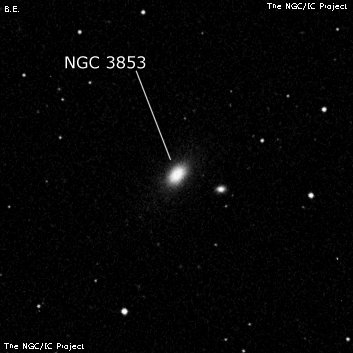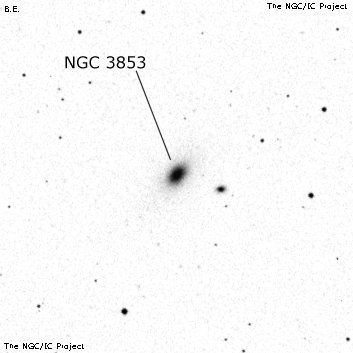NGC/IC Project Restoration Effort
(This is a very very beta version)
NGC3853


Basic Information
Location and Magnitude
Right Ascension: 11:44:28.3
Declination: +16:33:30
Constellation: LEO
Visual Magnitude: 12.4
Historic Information
Discoverer: Herschel W.
Year of discovery: 1783
Discovery aperture: 18.7
Observational
Summary description: S, R, bM
Sub-type: E4
Corwin's Notes
=====
NGC 3853. Wolfgang Steinicke has suggested that this galaxy was actually
discovered by WH on 30 December 1783, early in WH's amazing first year of
sweeping the sky with his 20-foot reflector. WH says of it (from CH's fair
copy in the Herschel Archives):
Some minutes after 32 [clock time] I saw a S Neb. but in looking a good
while at the finder to determine is [sic] place lost it again. I suspect
partly that it only consisted of a few vS st. but shall look for it another
night. 95 (o) Leonis f .... n 0[deg] 54[arcmin] RA 11h 3[min]:: .. PD
72[deg] 20[arcmin].
It never made it into WH's catalogues, probably because of the uncertain RA.
He certainly never recorded it again, so probably did not search for it as he
said he would.
There are only three objects in the sweep: this one, 95 Leo, and NGC 4028
(which see). Unfortunately, WH did not record a time for the transit of the
star (or the first nebula), so had no way to reduce the right ascensions of
the two nebulae. He managed to find an approximate position for NGC 4028
using the clock correction from the previous sweep on the same night, but with
no time recorded for this nebula, only an approximate RA could be deduced --
and it is well off the true value which should be 11 34 06, 72 20. However,
the declinations for all three objects are correct, and the objects at least
occur in the sweep in the same order as they appear on the sky.
It was left to Alphonse Borelly to rediscover NGC 3853 in 1872 (and he
measured it micrometrically), so he is its sole observer credited by Dreyer in
the NGC.
Steve's Notes
=====
NGC 3853
17.5" (3/29/89): fairly faint, fairly small, elongated NW-SE, halo increases to a small bright core.



